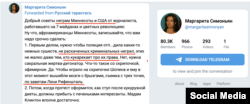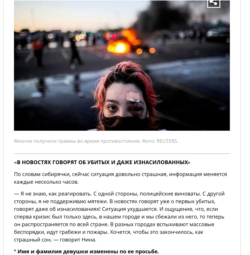“Friendly advice to the negroes of Minnesota and the U.S.A. from a journalist,” the Telegram post on May 30 reads in Russian.
Shared over 53,000 times, the post is a sarcastic 13-point “plan” on how to run a “Maidan-type” revolution – a reference to the 2014 protests and unrest that forced a change in Ukraine’s government.
The post uses racially disparaging language, and to “ignite” a revolution it recommends staging a 3D video-recorded police beating with “brains and blood flying around” in the best practices of Leni Riefenstahl (Adolf Hitler’s propaganda film director).
The victims have to be “gentle creatures, not ripped criminal negrillos,” the post says, because no one cares about the latter, even those people “crowing like roosters” about their rights.
The post goes on to suggest setting up a stage where “negroes’ folk dance twerk” would be performed 24/7 and assigning “black bros” to cook amphetamine and meth. The last sentence reads: “Beat whites until they turn black!”
The text was reposted on the Telegram by Margarita Simonyan, the editor-in-chief of RT (state-owned news outlet Russia Today) and published in a more polished form (although still containing racial language) in one of Russia’s most popular newspapers.
The author of the post is Dmitry Steshin, special political correspondent for Komsomolskaya Pravda (KP), a national tabloid. It appeared in the paper’s “World politics” section.
KP distributes more copies than any other newspaper in Russia – about 40 million monthly - and its website has 20 million visits a month.
Since the protests over Floyd’s death in police custody began in the U.S. on May 25, Komsomolskaya Pravda has run a series of reports from different American cities. Each has cited a local resident, an eyewitness who happens to be a “Russian girl” asking to remain anonymous.
The life stories of these girls are slightly different, though oddly they all came to the U.S. from Siberia. At first glance, their accounts of U.S. events seem fairly credible, but there are distortions.
A June 1 KP story about Minneapolis, which described the city “drowning in hatred,” quoted a “Russian girl” describing chaos and peoples’ fear of being “abandoned by the police” and left to the mercy of violent protesters.
"In the news, they are now are talking about the first people killed and even raped in Minneapolis,” she is quoted as saying.
This is false.
While violence, injuries, looting and damaged property have been widely reported, VOA was unable to find any media or law enforcement reports of protest-related rapes in Minnesota.
According to the Associated Press, at least 11 people have been killed nationwide during the protests, with three cases directly linked to the unrest and others still under investigation, including the one in Minneapolis. (The news report about Minneapolis death came out on June 2 – a day after KP piece was published.)
The same KP story reported that “walking to the vigil people created at the site of George Floyd’s death is prohibited after the Pentagon brought the troops in.”
That is also false. On May 28, Minnesota Governor Tim Walz declared a state of peacetime emergency and activated the National Guard, but no troops were brought in from out of state. The nighttime curfew which Waltz ordered the following day only prohibited outdoor activities from 8 p.m. to 6 a.m.
The site of George Floyd’s death is open to the public and has become a place for people to gather and share their grief.
Margarita Simonyan is the chief editor of the Russian government’s multimillion-dollar media conglomerate MIA Rossiya Segodnya, which includes RT and Sputnik. She did not explain why she shared Steshin’s Telegram post.
When Simonyan’s re-post came under scrutiny from Bellingcat, an investigative website, RT’s Twitter account tweeted that many in Russia are ignorant of the racist connotation the label “negro” has for some in the U.S.
Simonyan lived and studied in the U.S. during her senior year of high school. She has previously used the word “negro/s”.
Another prominent Russian capitalizing on the U.S. unrest is Ramzan Kadyrov, the governor of Chechnya, who has been repeatedly criticized by Human Rights Watch, Amnesty International and the U.S. government for a range of civil rights violations and attacks on journalists.
“With horror I am watching the situation in the U.S., where the rights of common citizens have been brutally violated by the authorities,” Kadyrov wrote in a statement published on the website of Ekho Mosvky (Echo of Moscow) radio station.
In the United States, various commentators took note of the irony in Russia’s response to the Floyd protests.
“America’s heartbreak brought considerable joy to Vladimir Putin’s Russia, but the gloating also exposes the deep ugliness of his regime,” U.S. analyst Julia Davis wrote in a Daily Beast piece about Russian media coverage.
Iran and China also accused the U.S. government of hypocrisy and cited the events to defend their own controversial policies, such as China’s crackdown on the Hong Kong protests, which politicians, the State Department and others have criticized.
“The whole world has watched as things unravel in the U.S.,” Chinese Foreign Ministry spokesman Zhao Lijian said Monday, according to the Washington Examiner. “American politicians had better get their own house in order.”
Zhao’s comment came just ahead of the June 4 anniversary of the Chinese government’s violent suppression of protests in Tianamen Square in 1989. Hundreds are believed to have been killed.
The network analysis firm Graphika issued a report Wednesday that used artificial intelligence to review social media traffic. The report cited a graphic posted by Russia’s Sputnik outlet stating: “America 2020: Where anti-racists are terrorists and racists are president.”
According to NBC, the Graphika analysis did not find evidence of a covert Russian campaign to influence the protests.
Russia’s response to the Floyd protests has historic precedent.
Jelani Cobb, a Columbia Journalism School professor, wrote an article published in The New Yorker magazine in 2018 headlined, “The Enduring Russian Propaganda Interests in Targeting African-Americans." Cobb was writing in the context of Russia’s interference in the 2016 U.S. election in an effort to help Trump win.
"During the Cold War, Soviet school curricula highlighted the exploitation of black people as a prime example of both American hypocrisy and of the rapacious nature of the capitalist system,” Cobb wrote. “Communist publications in the United States hired black writers and advocated for racial equality. That propaganda tradition of the old Soviet Union came back into view with Vladimir Putin, former KGB agent."
A study of social media posts conducted for the U.S. Senate Select Committee on Intelligence found that prior to 2016, Russian state-backed internet operatives “created an expansive cross-platform media mirage targeting the Black community, which shared and cross-promoted authentic Black media to create an immersive influence ecosystem.”
That included posting thousands of YouTube videos relating to Black Lives Matter and police violence and maintaining 30 Facebook pages directed at African Americans that attracted more than 1 million followers.
At the same time, Russian operatives created anti-Black Lives Matter accounts on social media, purchasing ads and promoting white supremacist ideology, The Washington Post reported.
In a blog post summarizing its study, Graphika noted that Russian media and media posts about the Floyd protests attacked Human Rights Watch, falsely accused former President Barack Obama of inciting violence, called Trump a “coward” and condemned attacks by police on journalists covering the demonstrations.
“Overall, however, the Russian coverage and commentary on the U.S. protests focused more on the nationwide unrest and the authorities’ response, in line with earlier practice of reporting on genuine grievances in the West and letting the events speak for themselves,” Graphika said.








